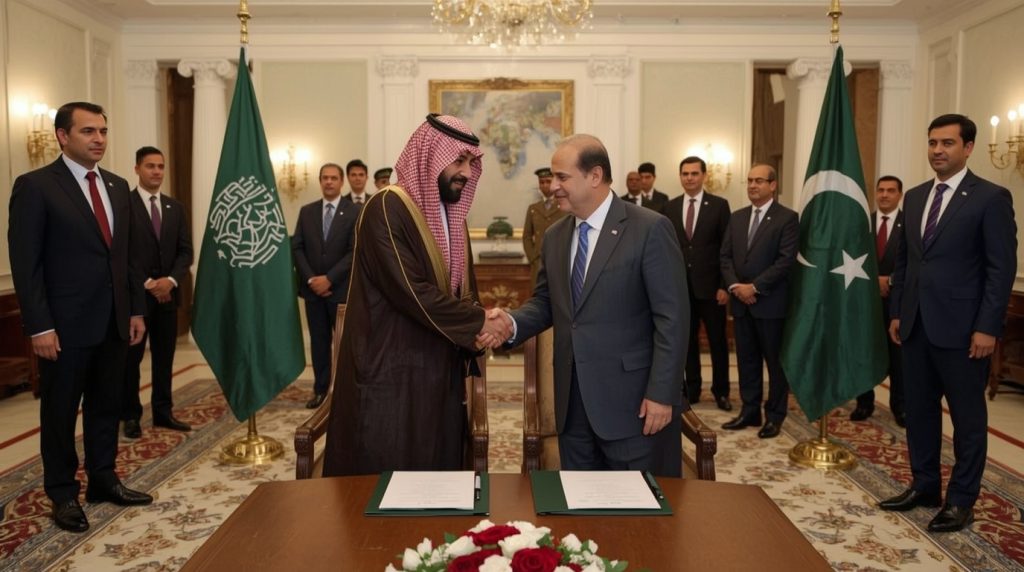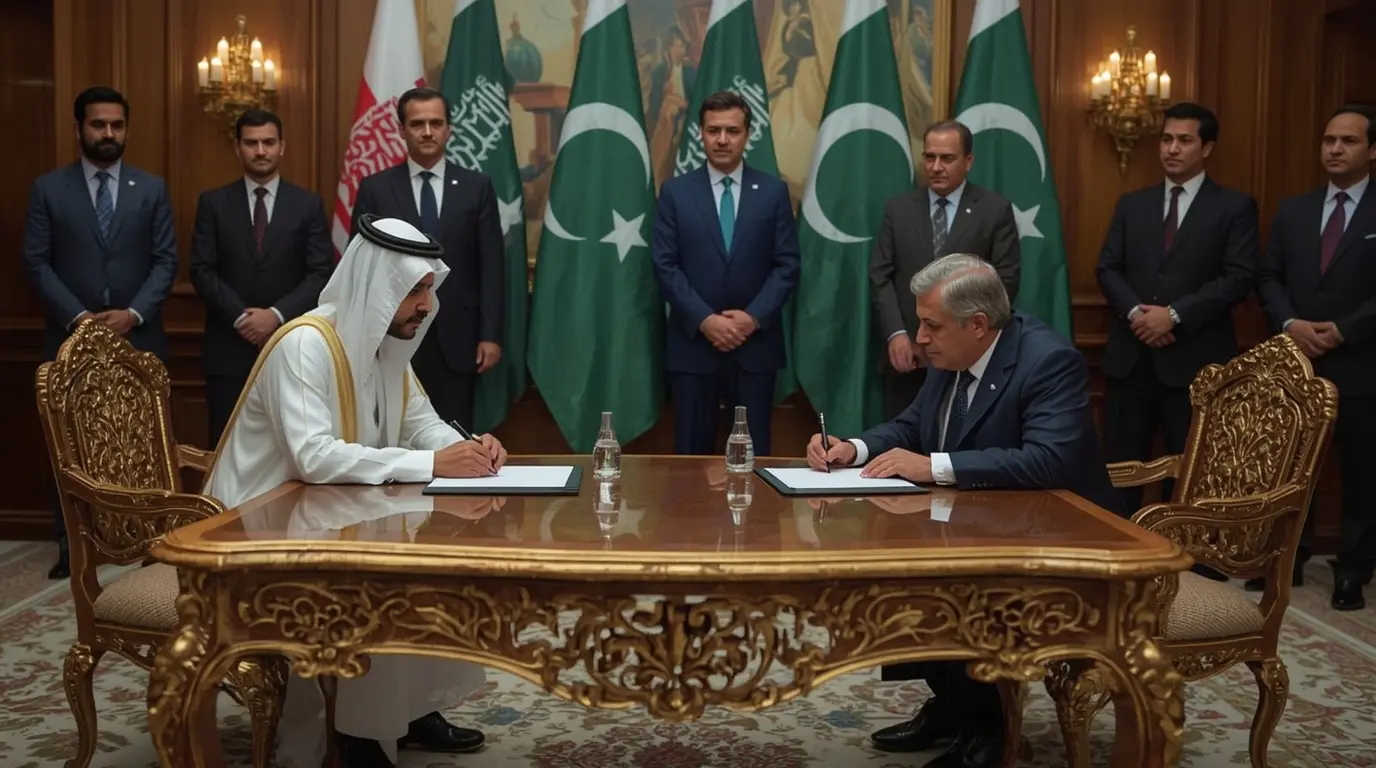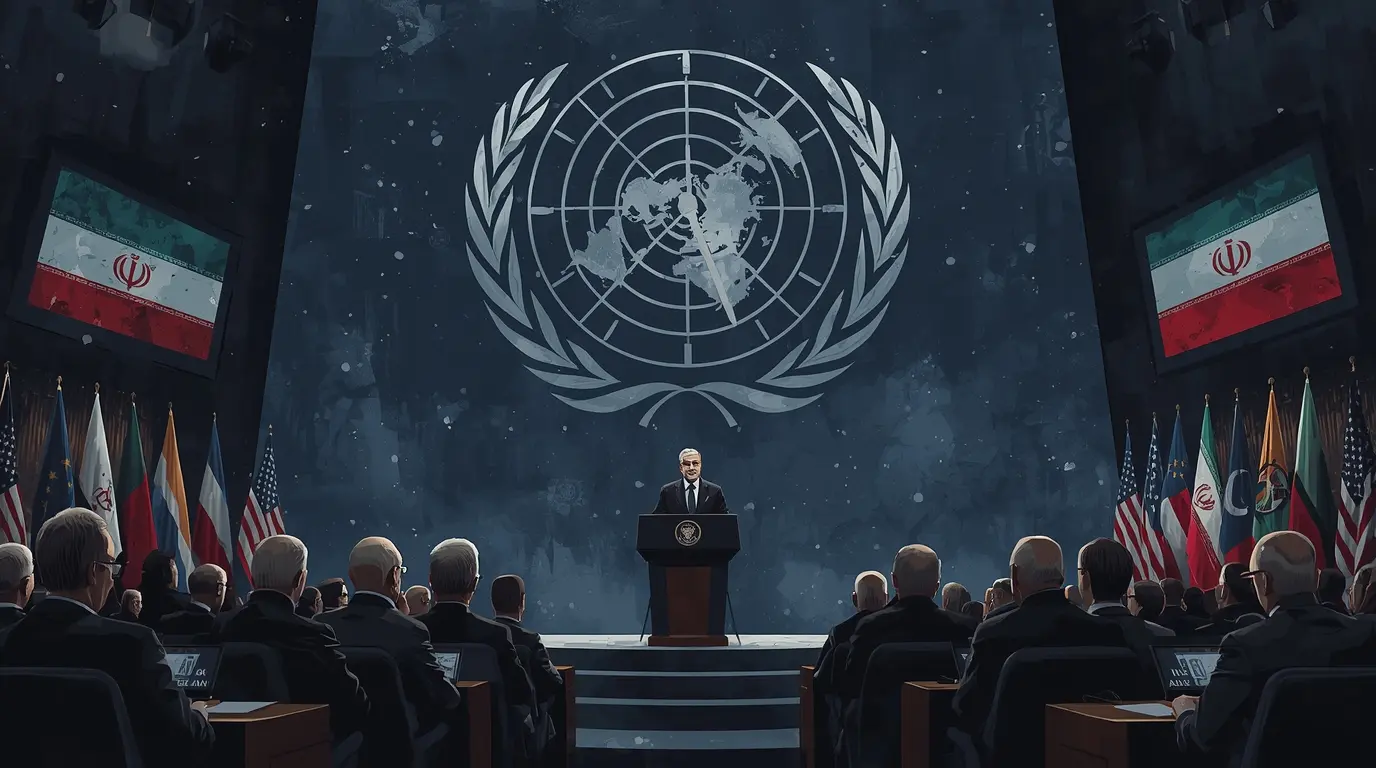A Transformative Defense Pact in a Volatile Region
On September 17, 2025, Saudi Arabia and Pakistan took a big step in changing how security works in the Middle East by signing a defense pact that promises both nations will back each other if either comes under threat. This deal arrives after many talks stretched over years and lands in a period of heightened uncertainty in the region. By framing the defense pact, the two countries are moving their past informal understandings into a formal structure that could shift the balance of power and possibly set in motion a fresh circle of outreach among other Muslim states.
The ceremony took place in Riyadh, where Prime Minister Shehbaz Sharif of Pakistan and Crown Prince Mohammed bin Salman of Saudi Arabia, joined by Pakistan’s top military official, Field Marshal Asim Munir, sealed the document with a handshake. Their embrace before the cameras underscored the defense pact’s implications and projected a clear signal that the alliance is solid. This deal is among the largest security covenants among Muslim countries in the past several decades.
Historical Context of Saudi-Pakistan Relations
The new Saudi-Pakistan defense pact builds on a partnership that began in the 1960s and has since become a cornerstone of both countries’ defence strategies. Pakistan has longtime seen itself as the guardian of the two holiest sites in Islam, with the first contingent of Pakistani troops arriving in Saudi Arabia in the late 1960s, prompted by worries about turmoil in the Middle East. Ties deepened after the 1979 Iranian Revolution raised Riyadh’s fears about growing Iranian influence.
Military training has always been a pillar of the partnership. To date, Pakistan has educated and prepared more than 8,200 Saudi servicemen across all branches of the armed forces since 1967. The two countries have staged a variety of joint drills over the years, the most notable being the ongoing “Al-Samsam” exercises, which have steadily sharpened the forces’ joint capabilities even before a defense pact was signed. Relations encountered a strain in 2015 when Islamabad opted out of a direct participation in the Saudi-led operation in Yemen, yet recent activities indicate that the differences have now been set aside and that the partnership is being consolidated through the newly signed defense pact.

Key Provisions of the Agreement
At the heart of the new defense pact lies a mutual support clause that explicitly declares, “any hostile action against either country shall be deemed a joint concern.” This language is eerily familiar to that of NATO’s Article 5 and is a powerful warning to any would-be aggressors. Officials label the document a “comprehensive defensive agreement covering all military means,” yet both sides purposefully leave it unclear whether this usage extends to Pakistan’s strategic assets.
In addition to the mutual defense pact, the pact seeks to “enhance the cooperative dimension of security and bolster joint deterrence against outside pressures.” Officials read this as a mandate for more frequent joint military drills, expanded intelligence sharing, structured technology transfers, and a shared research and procurement agenda. In effect, the treaty raises an informal partnership to the status of a formal legislative body, setting the stage for scheduled meetings and a more orderly process for making the combined security decisions that will shape both nations for years to come.
Key Elements of the Saudi-Pakistan Defense Pact
| Component | Description | Potential Impact |
|---|---|---|
| Mutual Support Clause | Agrees that any threat to one partner equals a threat to both. | Boosts deterrence against neighboring states. |
| Comprehensive Military Cooperation | Covers “all security means” to link both militaries. | May lead to combined drills, intelligence sharing, and joint operations. |
| Institutional Framework | Turns informal security talks into a formal structure. | Creates regular planning bodies and timely joint drills. |
| Strategic Alignment | Aligns both countries’ security strategies and force postures. | Presents a cohesive stance on regional matters. |
Regional Tensions and Timing Considerations
This defense pact was finalized only a few days after an Israeli strike on Doha on September 9 that reportedly killed six Hamas members. The raid followed right after closed-door Qatari efforts to broker a Hamas ceasefire. The operation heightened anxieties in Arab and wider Islamic circles. Saudi diplomats stress that the defense pact was already in the works and serves to codify existing security ties. Still, the announcement right after the Qatari incident undoubtedly signals the two states’ willingness to strengthen their security partnership amid volatile surroundings.
Gulf Arab states have grown more skeptical about the U.S. being a dependable security partner. The belief that the Trump White House quietly sanctioned Israel’s moves in Qatar only deepened this skepticism, pushing the Gulf monarchies to look for other ways to defend themselves. A growing defense agreement with a nuclear Pakistan marks a significant shift for Saudi Arabia, which has relied heavily on Washington for security over the past half century.
Widening the picture, Israel has ramped up military operations in the Arab world since the Hamas attack on October 7, 2023. Campaigns have been reported in Iran, Lebanon, the Palestinian territories, Qatar, Syria, and Yemen, suggesting that Riyadh is trying to signal its own security limits. By striking this deal with a nuclear-capable Pakistan, the Kingdom is placing a serious deterrent on the table.
Nuclear Aspects of the Agreement
The fact that Pakistan brings its nuclear arsenal to the deal cannot be understated. Islamabad is believed to have about 170 strategic warheads, making its deterrent hard to overlook. Speculation has circulated for years that Saudi Arabia quietly supports Pakistan’s nuclear efforts, with some reports crediting Riyadh for providing “generous financial assistance” to help Islamabad expand its capabilities.
When questioned whether the recent agreement implies a formal Pakistani duty to shield Saudi Arabia with a strategic security umbrella, a senior Saudi official carefully replied, “This is a broad defensive accord that includes all military assets.” Deliberate vagueness serves both parties by obfuscating exact commitments, thereby unsettling would-be adversaries while reserving interpretive flexibility for changing conditions down the road.
In recent years Riyadh has pursued American backing for a civil nuclear scheme featuring uranium enrichment, a move alarmingly noted by nonproliferation analysts. Crown Prince Mohammed bin Salman has openly warned that the kingdom would develop nuclear arms should Iran cross a similar threshold. The current discourse with Islamabad may thus provide a third option for strategic deterrence, short of an entirely home-grown plutonium program.
International Responses and Complications
New Delhi, traditionally wary yet diplomatically cultivating Saudi Arabia, has reacted cautiously. External Affairs Ministry spokesman Randhir Jaiswal remarked that officials would “assess the repercussions of this accord for national security and for regional and global stability.” The agreement is triggered a few months after a high-intensity brief exchange of fire between the two south-Asian nuclear states in May 2025, which left an estimated 70 dead in a matter of days.
Saudi leaders wasted no time pointing out to reporters that ties with India are “stronger than ever” and that “this partnership will keep growing.” Such statements serve their economic goals: India is the Kingdom’s second-largest trade partner at nearly $42 billion, outpacing the roughly $3 to $4 billion figure with Pakistan.
Traditionally, the U.S. has provided the Gulf with security guarantees, yet Washington has neither celebrated nor questioned the recent deal. This quiet is noteworthy, especially since the defense pact could shift security calculations, altering the balance of influence that the U.S. has relied on for decades.
Implications for the Regional Security Architecture
The new defense pact will reshape the security map of the Middle East. By tying the Gulf’s wealth to India’s nuclear arsenal and advanced conventional forces, it redraws the strategic calculus for multiple flashpoints: Yemen’s balance shifts, Iranian posture is reassessed, and responses to the Israeli-Palestinian conflict may tilt in new directions. As the alliance forms, price tags on previously accepted risks will inevitably rise.
For Pakistan, the new defense pact is a big diplomatic win that boosts its influence in the region. But this success has a downside: Islamabad might get pulled deeper into Middle Eastern rivalries, especially concerning Riyadh’s worries about the Houthis in Yemen. The mutual support clause in the deal could eventually mean Pakistan has to back Saudi Arabia in different situations, which adds a layer of risk Pakistan needs to consider carefully.
On a wider scale, the deal shows a growing trend where regional powers are choosing to manage their own security rather than lean on major global players. This could slowly reshape security in the Middle East into a more multipolar model, where new groups of influence are formed around a mix of religious ties and practical interests. If this trend holds, the region might look very different in the coming years.
Potential Obstacles Ahead
Putting this sweeping agreement into practice will not be easy. Pakistan will have to juggle ties with other regional players while trying to keep a low profile in various escalations. The defense pact’s vague wording on what “hostile action” really means could be double-edged. On one hand, it might strengthen deterrence by making enemies think twice; on the other hand, it leaves critical room for interpretation that could lead to misjudgment during a tense crisis. This ambiguity will require careful diplomatic handling to avoid unintended triggers and keep the situation manageable.
The economic pillar of the Saudi-Pakistan defense pact leans heavily toward Riyadh, which commands far greater fiscal clout than Islamabad. This disparity risks silent strain over who shoulders which costs and who gains the louder say-so. How the deal prices and pools its burdens and privileges will matter for whether it staggers past tomorrow or thrives for years.
Nuclear nonproliferation watchers are alert to whether the pact spills over into technology or credential movement from Islamabad to Riyadh. Even modest atomic mastery crossing the Red Sea would reset the calculus for security calculators from Tehran to Washington. So far, the two capitals say the deal is strictly conventional and aimed more at the threat of missiles than at more arcane physics.
Fresh Security Currents
The Saudi-Pakistan framework signals a marked veer in the Middle Eastern security menu. Wander around the region for a moment and you will hear monarchs fretting that old-school American security blankets are now pizza deliveries to be negotiated in the wake of Ukraine and Afghanistan. Plug Islamabad, an army headquarters that is also a nuclear supplier, into the tape, and the region is left with metal, money, and an alternate in cousin security. From Bab el-Mandeb to Khyber, the stakes now include who will vouch for loyalty when the tanks are counted and the trees are measured for bombs.
While we won’t know the full meaning of this deal for years, it immediately sends a strong message to several regional players that the rules for security alliances in the Middle East are already shifting. First, the defense pact shows that Saudi Arabia is prepared to set up security partnerships on its own terms, beyond its decades-old ties with the United States. For Pakistan, the deal means a boost in regional standing plus the chance of more trade and investment.
Ongoing disputes and friction across the region—from Iran and Iraq to the Gulf, the Levant, and the Red Sea—mean that capitals in Tehran, Jerusalem, and Washington will certainly be recalibrating their assumptions. Over the next few months we will see whether this agreement is merely a further showing of Islamic curser fire, lit after decades of mutual denials, or whether it turns into a working security partnership that could start changing the existing balance of power in what is still one of the world’s more dangerous neighbourhoods.
Source: https://edition.cnn.com/2025/09/17/middleeast/saudi-arabia-pakistan-defense-pact-intl-hnk
For more incredible stories of everyday news, return to our homepage.




